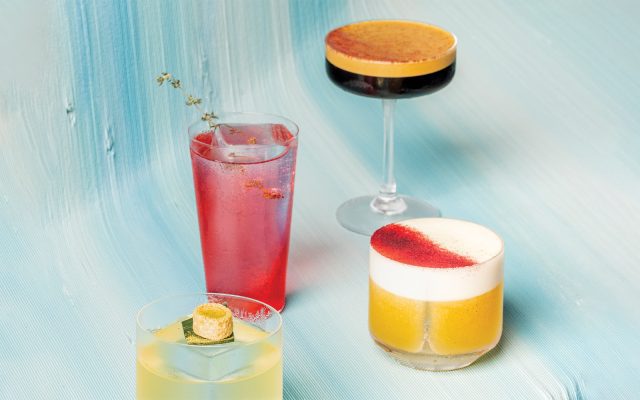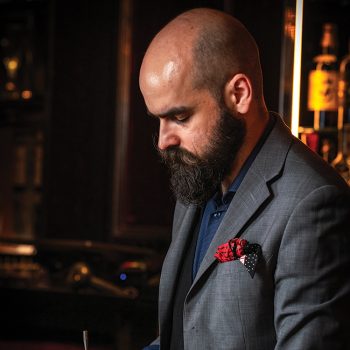What should a ‘good’ non-alcoholic cocktail be?
The increasing popularity of low- and no-alcohol drinks has posed bartenders a challenge to create cocktails with as much depth, flavour and mouthfeel as their boozy counterparts.

*This feature was originally published in the January 2024 issue of The Spirits Business magazine.
“What should a non-alcoholic cocktail be? It has to be delicious. And if it can tell a story, well then that’s great. Without both, it’s not interesting,” says Christian Rodriguez, beverage director at New York’s ElNico.
It’s an essential point. What should a ‘good’ non-alcoholic cocktail be? Should it quench or intrigue? Should they mimic full-strength serves? Or should they take the sensory elements of what we enjoy about alcohol and set out to do something different?
Whether you abstain, moderate, or find January a tricky time to forgo a stiff cocktail, the first month of the year has become a barometer of the state of the non-alcohol industry. While non-alcoholic ‘spirits’ are not even a decade old, complex and satisfying non-alcoholic cocktails are even younger. Technically tricky to create, ambiguous in their form, and confusing to unaccustomed consumers, it’s understandable that many bars – even among the world’s best – have shied away from fleshing out their non-alcoholic cocktail menus.
Blank canvas
Yet while the lack of rules or deeply established customs around them remain a challenge, for a growing number of bars they also represent an exciting blank canvas to play with. From flag-flyers for the category such as Ryan Chetiyawardana at Dandelyan then Lyaness et al, to Michelin Guide-listed restaurants such as Berlin’s Kink, to Seoul’s Charles H bar, which in 2021 gave 30% of its menu over to non-alcoholic drinks, their reach is global.
“When we designed the cocktail programme, we were not specifically working on whether it would be alcoholic, or not,” says ElNico’s Rodriguez. “We start from a flavour perspective.” The rooftop Mexican bar and restaurant only opened in May 2023, but alongside mixologist Leo Robitschek, the duo (both formerly of NoMad, and Eleven Madison Park), have created a non-alcoholic menu that stands apart.
Its five-serve menu includes the Pea Shrub, which uses Seedlip Garden, peas, of course, cider vinegar, cucumber, and sparkling mineral water. The Mango Batido combines a bar-made mango-infused whey, with buckwheat tea and egg white. And the Chica Morada Agua Fresca uses boiled purple corn, hibiscus, and rhubarb, alongside cinnamon. Combining culinary and cultural influences from the team’s Mexican, Venezeulan and Peruvian roots, it tells the story of seasonal flavours and reworked regional staples.
With processes including lactic fermentation, to create deeper, more complex flavours from single ingredients, to creating fruit-flavoured whey to add acidity and body, and largely eschewing spirits alternatives, the aim is to have serves that stand apart from alcohol.
“I think non-alcoholic serves should stand on their own, 100%,” Rodriguez adds. “There is so much freedom to be creative with non-alcoholic serves. You’re not bound to the structure of, say, an Old Fashioned, Paloma, classic Martinis, Negronis, Sours. If anything, you have to hold yourself back. In many cases, we create ingredients. There’s always been that bouncing around of ideas between the kitchen and the bar. It makes sense.”
Push the boundaries
One bar not holding itself back, either in its concept or its menu, is Singapore’s Analogue Initiative. Vijay Mudaliar’s sustainability-focused second venue (following the award-winning Native) sets out to push the boundaries of what a bar can be, and what ingredients we should be consuming, with a rethink of the sourcing and use of materials, and showcasing of ingredients of the future.
It’s an all-encompassing approach, from a bar 3D printed from recycled plastic bottles, to table tops that use fungus to “self grow”, to a plant-based menu that avoids over-farmed ingredients. Chicory is used in place of coffee, methylcellulose rather than egg whites. With seven cocktails, the ‘dry’ menu has just two serves less than the full-strength one. “Being more inclusive is something that we try to do in all our venues, in terms of the design of the venue and also the design of the menu,” says Mudaliar.
“If we want to challenge ourselves, the hardest thing to do is come up with great non-alcoholic programmes. In the beginning, we were looking at alcoholic cocktails, and reflecting them.
“That’s where we were failing. We had to strip it down and look at it in terms of flavour profiles, and lean a bit more towards the perfume industry and how they put scents together, how a single scent could be so intense, and take that and try and put it in liquid form.”
There’s the Blue Magic, based on the idea of a tonic, with better-for-you ingredients from blue spirulina, to liquorice, goji berries, cardamom, made into a cordial and combined with jasmine kombucha, and magnesium for a velvety mouthfeel, and acidity. Other functional ingredients include ashwagandha, which also adds bitterness, vitamin C for sharpness, and vitamin E. “Why not make it good for you?” adds Mudaliar.
Nicholas Leong, head of R&D at Analogue, says for the Verdis Quo serve (made of peach, lapsang souchong, verjus, ginger, B12 and folic acid) “we did our own fermentation, and made our own lapsang souchong, kombucha, alongside peach and methylcellulose, to add acidity and complexity to it”.

Body is vital for a satisfying serve, says Michal Janusz Maziarz, bar manager at London’s Baccarat Bar in Harrods. That, and creating drinks that are complex enough for “a refined palate to find interesting, without putting off someone who wants a pineapple juice with lemonade and raspberries”.
The bar’s new menu, Through the Creative Lens, is inspired by photography, and its ability to transform. The four non-alcoholic options, representing a quarter of the menu, include Heatwave, its only 0%-ABV cocktail, that uses Everleaf Forest, salted mango, earl grey tea, and hot penja pepper, and its counterpart Cold Snap (at under 1% ABV) made with Everleaf Marine, the mango and tea again, alongside a cooling, tincture made from clarified menthol, rum, and milk.
The Manhattan Project (<0.5%, buffered reserve Sherry vinegar, verjus, cola-spiced grape juice) is for those who want the sensation, mouthfeel, and even flavour that alcohol can bring. Both that and Coque & Smoke (<0.5%, reserve Sherry vinegar, homemade grape cola) contain an Ardbeg single malt vinegar, inspired by techniques that originate from Copenhagen’s famed Noma restaurant.
The alcohol is burned off, balanced to 8% ABV, and converted to a vinegar with acetic acid and oxygen. The bar’s adapted technique also uses a rotovap, to capture the heavier, oily, smoky compounds in the vinegar. “It’s not excessively acidic, it’s not very aggressive, but it is complex, aromatic, and very grown up,” adds Maziarz.
Meet the challenges
From using ultrasound to extract spice flavours, to (sometimes maligned) glycerine to boost mouthfeel – “if you want to create something that has a mouthfeel, appearance, and elegance of a stirred-down cocktail, this is a game changer” – the aim is to deliver sensorially. “I think a lot of the guests still have difficulty in explaining what they are looking for in a non-alcoholic drink,” he adds. “And they have a very binary vision of what alcoholic and non-alcoholic drinks are. But the bigger the challenge, the more fun. The challenges inherently linked to non-alcoholic drinks are definitely the most fun to figure out, and are the most satisfying once we get it right.”
Related news
Inside the ‘spiritual home’ of Scotch
